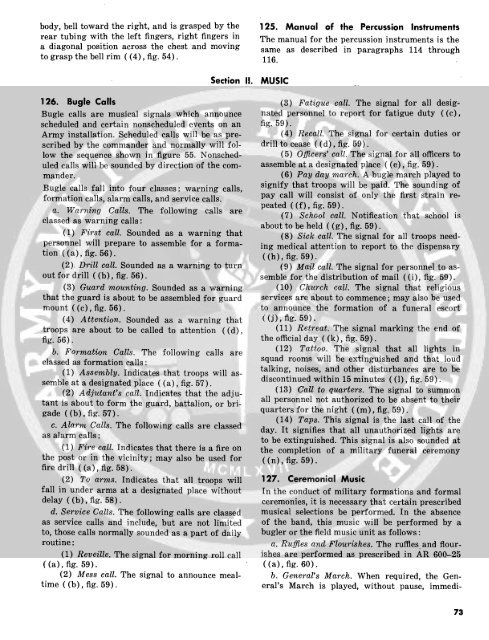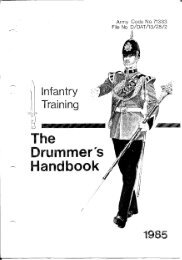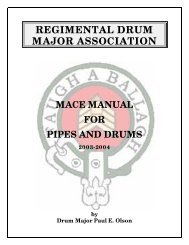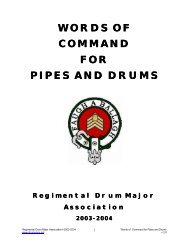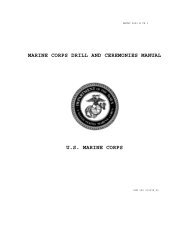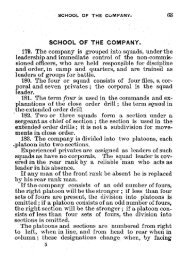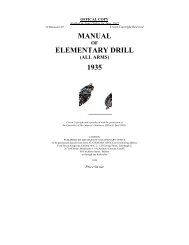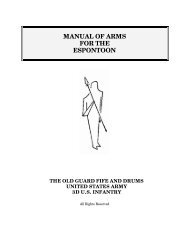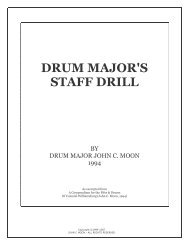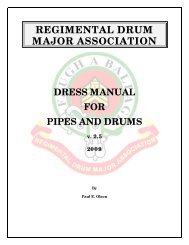The Military Band - Regimental Drum Major Association
The Military Band - Regimental Drum Major Association
The Military Band - Regimental Drum Major Association
You also want an ePaper? Increase the reach of your titles
YUMPU automatically turns print PDFs into web optimized ePapers that Google loves.
ody, bell toward the right, and is grasped by the 125. Manual of the Percussion Instruments<br />
rear tubing with the left fingers, right fingers in <strong>The</strong> manual for the percussion instruments is the<br />
a diagonal position across the chest and moving same as described in paragraphs 114 through<br />
to grasp the bell rim ((4), fig. 54). 116.<br />
Section II. MUSIC<br />
126. Bugle Calls (3) Fatigue call. <strong>The</strong> signal for all desig-<br />
Bugle calls are musical signals which announce<br />
scheduled and certain nonscheduled events on an<br />
nated personnel to report for fatigue duty ((c),<br />
fig. 59).<br />
Army installation. Scheduled calls will be as prescribed<br />
by the commander and normally will follow<br />
the sequence shown in figure 55. Nonscheduled<br />
calls will be sounded by direction of the commander.<br />
(4) Recall. <strong>The</strong> signal for certain duties or<br />
drill to cease ((d), fig. 59).<br />
(5) Officers' call. <strong>The</strong> signal for all officers to<br />
assemble at a designated place ( (e), fig. 59).<br />
(6) Pay day march. A bugle march played to<br />
Bugle calls fall into four classes: warning calls,<br />
formation calls, alarm calls, and service calls,<br />
a. Warning Calls. <strong>The</strong> following calls are<br />
(1) First call. Sounded as a warning that<br />
personnel will prepare to assemble for a formation<br />
((a), fig. 56).<br />
signify that troops will be paid. <strong>The</strong> sounding of<br />
pay call will consist of only the first strain repeated<br />
((f), fig. 59).<br />
(7)<br />
(7)<br />
School<br />
School<br />
call<br />
call.<br />
Notification<br />
Notification<br />
that<br />
that<br />
school<br />
school<br />
is<br />
is<br />
about to be held ( (g), fig. 59).<br />
(8) Sick call. <strong>The</strong> signal for all troops need-<br />
ing medical attention to report to the dispensary<br />
((h), fig. 59).<br />
(2). Drill call. Sounded as a warning to turn<br />
out for drill ( (b), fig. 56).<br />
(9) Mail call. <strong>The</strong> signal for personnel to as-<br />
semble for the distribution of mail ((i), fig. 59).<br />
(3) Guard mounting. Sounded as a warning<br />
that the guard is about to be assembled for guard<br />
mount ((c),fig. 56).<br />
(10) Church call. <strong>The</strong> signal that religious<br />
services are about to commence; may also be used<br />
to announce the formation of a funeral escort<br />
(4) Attention. Sounded as a warning that<br />
troops are about to be called to attention ((d),<br />
fig. 56).<br />
((j), fig. 59).<br />
(11) Retreat. <strong>The</strong> signal marking the end of<br />
the official day ((k), fig. 59).<br />
b. Formation Calls. <strong>The</strong> following calls are<br />
classed as formation calls:<br />
(1) Assembly. Indicates that troops will as-<br />
(12) Tattoo. <strong>The</strong> signal that all lights in<br />
squad rooms will be extinguished and that loud<br />
talking, noises, and other disturbances are to be<br />
semble at a designated place ((a), fig. 57). discontinued within 15 minutes ((l), fig. 59).<br />
(2) Adjutant's call. Indicates that the adjutant<br />
is about to form the guard, battalion, or brigade<br />
( (b), fig. 57).<br />
(13) Call to quarters. <strong>The</strong> signal to summon<br />
all personnel not authorized to be absent to their<br />
quarters for the night ((m), fig. 59).<br />
c. Alarm Calls. <strong>The</strong> following calls are classed<br />
(14) Taps. This signal is the last call of the<br />
c. Alarm Calls. <strong>The</strong> following calls are classed day. It signifies that all unauthorized lights are<br />
to be extinguished. This signal is also sounded at<br />
(1) Fire call. Indicates that there is a fire on the completion of a military funeral ceremony<br />
the post or in the vicinity; may also be used for ((n), fig. 59).<br />
fire drill ((a), fig. 58).<br />
(2) To arms. Indicates that all troops will 127. Ceremonial Music<br />
fall in under arms at a designated place without In the conduct of military formations and formal<br />
delay ((b), fig. 58). ceremonies, it is necessary that certain prescribed<br />
d. Service Calls. <strong>The</strong> following calls are classed musical selections be performed. In the absence<br />
as service calls and include, but are not limited of the band, this music will be performed by a<br />
to, those calls normally sounded as a part of daily bugler or the field music unit as follows:<br />
routine: a. Ruffles and Flourishes. <strong>The</strong> ruffles and flour-<br />
(1) Reveille. <strong>The</strong> signal for morning roll call ishes are performed as prescribed in AR 600-25<br />
((a), fig. 59). ( (a), fig. 60).<br />
(2) Mess call. <strong>The</strong> signal to announce meal- b. General's March. When required, the Gentime<br />
((b), fig. 59). eral's March is played, without pause, immedi-<br />
73


